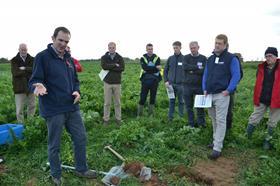
Soil organic matter is becoming one of the biggest talking points among growers, with many trialling green manure and cover crops as part of AHDB Horticulture’s GREATsoils project over the last year.
“Most growers, across all the different systems, are aware of and concerned about declining soil organic matter (SOM) levels and see a need for action,” explains Anja Vieweger, senior researcher at the Organic Research Centre. “They are looking for useful and efficient methods to measure and monitor soil life, but also practical methods for increasing active SOM, ultimately increasing soil fertility and productivity.”
The GREATsoils project has supported six field trials to monitor soil organic matter on crops ranging from field veg to topfruit, with knowledge exchange events delivered via on-farm events and online webinars and attended by over 300 growers, agronomists, researchers and consultants.
“Some of the best moments happened when we acted simply as catalysts for exchange of knowledge – when growers who had come together for one of our GREATsoils events got out into the field and started to compare experiences of soil management among themselves,” says soil technologist Martin Wood of consultancy Earthcare Technical. “It might be about green manures that have worked for them, or about a new soil analysis service that they’ve been trying out.”
Many growers now recognise the importance of green manures and cover crops as part of intensive crop rotations, but the cost of growing and fitting them into a tight rotation remains a challenge.
The Soil Association’s farm business advisor, Tim Bevan, says: “There is a need for more information and predictive tools on how to utilise green manures, and composts can replace chemical inputs meaning a financial benefit for growers.”
Another talking point has been the relationship between soil organic matter, soil structural condition and soil health. “If you’re new to soil structural assessment, use the available tools, such as Visual Soil Assessment (VSA) and Visual Evaluation of Soil Structure (VESS) to help you recognise what good and bad structure looks like,” says Paul Newell Price of research institute RSK ADAS.
“Measuring the depth, degree and thickness of a compacted layer (e.g. a tillage pan) is crucial to selecting the most appropriate cultivation and/or cover cropping method.
“Match your cultivations to the soil structural condition and the need to manage weeds and crop residues, but don’t cultivate any more than you have to. Consider controlled traffic farming; the approach requires total commitment and significant investment, but the benefits can be considerable.”
There is a wide range of participation on the project, with some growers at the on-farm data gathering stage and others working with research institutes and universities to test and validate techniques in fields.
Whatever stage it’s at, it’s clear that the momentum around soil health is only going to gather pace.
GREATsoils in 2017
This year, the GREATsoils project will release its first case studies on the use of compost to improve soil health and on a new approach to testing soil for carrot production. There will also be feedback from six grower trials and the results of the different methods for measuring and managing soil health on their farms across the country.
Parrish Farms will host a demonstration open day to discuss options for soil mapping in horticulture, looking at costs and benefits associated with different soil mapping techniques. In June, the project will visit G’s to look at managing soil and crop yield variability with a focus on vegetable and salad crops. Additional demonstration open days are planned on controlled traffic farming (CTF) and variable rate nitrogen.



